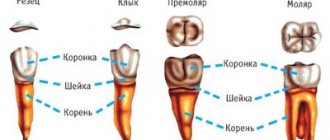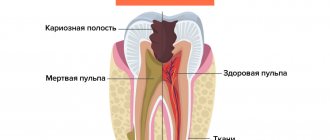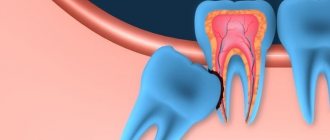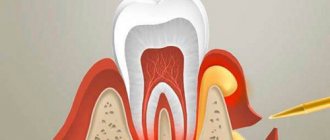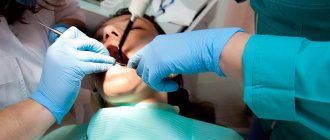Fused tooth roots are a fairly rare occurrence. According to statistics, they are detected in approximately 4% of patients who seek help from a dentist. Experts attribute the causes of the problem to:
- tooth dislocation,
- severe damage to the jaw,
- infection of the rudiment during eruption,
- violation of root resorption when changing teeth,
- long-term inflammation of soft tissues,
- genetic predisposition.
Find out if it's dangerous, what symptoms you shouldn't ignore, and how to treat it.
What is ankylosis
Tooth ankylosis is a pathology characterized by fusion of the cement of the tooth with the jaw bone. The tooth root is deprived of part of the ligamentous apparatus, which often leads to adhesion or germination of bone tissue. The aesthetics of the teeth are disrupted, they look shorter and change their angle. Ankylosis usually occurs during tooth eruption. Pathology can also form at a late stage in the formation of the dental arch.
It is important to know. The process is accompanied by periodontal necrosis and the incorporation of root cement into the alveolar bone.
Ankylosis of a primary tooth is caused by loss of the periodontal ligament. It is observed in cases where a primary molar does not fall out due to the absence of a permanent dental unit. Ankylosed teeth are different in size from their neighbors, so bite correction will be required.
Diagnostics, treatment, rehabilitation
The only way to identify fused tooth roots is with radiography. A targeted image allows you to examine the defect and determine whether correction is possible. Typically, such dental units must be removed.
Extraction of teeth with fused roots is considered a complex operation. It should be performed by an experienced dental surgeon. Before the procedure, the doctor carefully examines the x-ray, assesses the shape of the roots, their size and location. Tooth extraction is performed under local anesthesia.
During the procedure, soft tissues are severely injured. To avoid complications, the patient must follow the doctor's recommendations. After surgery, you should not wash out the blood clot, eat solid food or drink drinks through a straw, take a hot bath, or visit the bathhouse or sauna. If symptoms of inflammation appear, you should contact your dentist.
Symptoms
Parents should be wary of the fact that their child’s baby teeth are not falling out. It is fused to the bone and cannot easily separate from the alveoli, as is normal. If the pathology is not detected and treated in a timely manner, the child’s jaw begins to develop incorrectly. The diseased tooth is located lower than the others, and the neighboring teeth are placed at an angle in relation to it. Problems with bite occur.
Another scenario is also possible. The baby tooth does not erupt completely and is delayed in its development. Because of this, the permanent tooth also cannot develop, and after the milk tooth falls out, it becomes fused with the jaw. This is how ankylosis of permanent teeth occurs. The final diagnosis is made after analyzing the results of a computed tomography scan.
Good to know. The service life of ankylosed teeth is completely different. They can last for decades or fall out, thinning out the dentition.
Anomalies of magnitude
There are two forms of this type of deviation, including macrodentia (increase in the size of dental units) and microdentia (small teeth).
Macrodentia
With macrodentia, the size of dental crowns is significantly increased. The cause of the disorder is, in most cases, dysfunction of the endocrine system, which is characterized by the fusion of several rudiments together. The disease is localized mainly in the area of the upper incisors. Large teeth interfere with the process of eruption and growth of neighboring dental units, which leads to their abnormal arrangement and crowding. Giant teeth are found on or outside the dentition line. This is a serious cosmetic defect that causes serious functional impairment and psychological disorders. Pathologically enlarged teeth are removed, and the growth of adjacent teeth is corrected using prosthetics or braces.
Microdentia
Microdentia – teeth that are too small. The disorder mainly affects the upper lateral incisors, but may affect the incisors of the lower or both jaws. The cause of the anomaly has not been studied, but it is reliably known that it develops in genetically predisposed patients. With the problem of small teeth, patients develop too large interdental spaces, which significantly disrupts the aesthetics of the dentition. To correct the pathology, incorrectly growing teeth are removed or covered with crowns.
Treatment of ankylosis
Treatment of ankylosis with traditional orthodontic methods (braces) is impossible. The tooth grows into the bone and it is impossible to return it to its correct position. But restoring the functionality of the dentition is quite possible. In dental clinics, the method of treatment is selected individually in each individual case.
First of all, the patient is referred for a dental computed tomography scan. The dental surgeon studies panoramic images and draws up a treatment plan. Most often, surgical treatment methods are used: excess fibrous tissue is removed and joint mobility is restored. Crowns made of metal-ceramics, ceramics and zirconium dioxide are also used to treat dental ankylosis. With their help, the bite is corrected.
Prognosis and prevention
Consilium Dent clinic uses advanced methods of therapeutic, surgical, and orthopedic treatment of dental anomalies in patients. By skillfully combining them, experienced specialists are able to restore the aesthetics of a smile and ensure the normal functioning of the dental system, even if the degree of deviation is significant.
Prevention of anomalies in the formation and development of dental units begins during the period of intrauterine development of the fetus and is carried out throughout a person’s life. The main stages are as follows: monitoring the successful course of the prenatal period, caring for harmonious postnatal development, organizing a correct lifestyle while the baby is growing up, caring for dental health and general health throughout life. By conducting an annual preventive examination, the dentist identifies dental anomalies at an early stage, when the pathological process is still reversible.
Expert of the article you are reading:
Lack of teeth in humans: what is it and what does it mean?
What is jaw edentia? If in some species of animals the dentition is renewed continuously or at least repeatedly (for example, in Indian elephants), then people have only two sets of teeth - milk and molars. Unfortunately, they can be lost during life, and with some types of anomalies and diseases, a person initially lacks one, several or even all tooth germs. Adentia is a situation where there is a lack of teeth on one or both jaws. In this case, the absence of eights is not taken into account, since they are a rudiment and may not appear in principle. Experts highlight the absence of primary and molar teeth. In the latter case, the loss is irreparable. Therefore, most often they talk about edentulous molars, taking into account the fact that all the most negative consequences of this disease are especially pronounced in adulthood.
What does missing teeth affect?
- Chewing dysfunction.
- Problems with the digestive system.
- Deterioration of aesthetics. The most noticeable consequence of edentia. A diagnosis of “missing teeth” is often a death sentence for a beautiful smile.
- Bone tissue atrophy. Without the load that the teeth bear, the bone tissue begins to dissolve. When there is a lack of teeth, over time the face seems to shrink in the lower part and those same senile sunken cheeks appear. This is a consequence of bone atrophy.
- Curvature of teeth. In the absence of teeth, the bite is disrupted and the dentition shifts. It also distorts a person's facial features.
- Problems with diction.
Unlike many dental diseases, signs of missing molars (as well as milk teeth) are very obvious. Diagnosis of edentia is usually carried out visually. However, to assess the condition of the bone tissue and the entire dentofacial apparatus as a whole, an x-ray examination is necessary. Now that it has become clear what jaw edentia is, it is necessary to talk about the causes and types of the disease.
Removal of wisdom teeth in teenagers
The rudiments of permanent teeth develop from the same epithelial dental lamina as the rudiments of temporary teeth. Since the eighth teeth have no predecessors in the primary dentition, they are called additional permanent teeth. The mechanism of their occurrence is similar to the appearance of the rudiments of baby teeth, but occurs at a later date. The rudiments of third molars (wisdom teeth) appear after the child is born, at about 4-5 years. This is due to the fact that newborn children have short jaws and simply do not have enough space for the formation of the rudiments of permanent teeth. The eruption of permanent teeth begins at approximately 6.5 years. Wisdom teeth are the last teeth to emerge, usually after the age of 18. However, with the current trend in children towards an earlier change, often the eruption of wisdom teeth can be observed already in 15-16 year old adolescents.
Third molars belong to the so-called vestigial organs. Evolutionarily, the dental system also undergoes changes, consisting in a decrease in the number of teeth while simultaneously complicating their anatomical structure, as well as a narrowing of the jaws due to the intake of softer food. Less than 10% percent of people do not experience problems caused by wisdom teeth. Rarely are there lucky ones who lack the rudiments of the third molars, or these teeth erupt into the dentition without causing any problems. Retention or semi-retention of eights is more common, that is, with their complete or partial incomplete eruption. As a rule, the reason for this is a lack of space in the dentition. Dystopia of the third molars is also common. All these features of teething lead to severe pain, trauma to the roots of the seventh teeth, pericoronitis, and the appearance of crowded teeth.
In this case, the third molars have to be urgently removed. The operation of removing a third molar is quite difficult for both the patient and even an experienced surgeon. This is mainly due to the unpredictable (even when using all modern diagnostic methods) anatomy of the eights and difficult access to the surgical field.
It is very easy to avoid such problems today. It is enough to remove the rudiments of the eighth teeth in adolescence, before the roots begin to grow. This procedure is quick and atraumatic. If the young patient is a little worried, the removal of the eighth tooth buds can be performed under superficial or deep sedation (depending on the severity of the anxiety). This is a global practice that is beginning to be actively introduced into Russian pediatric dentistry.
After the formation of a permanent bite is completed, the question arises about straightening the teeth using a braces system or aligners. In order not to spoil the resulting perfect smile after wearing an orthodontic system due to the eruption of wisdom teeth, which inevitably move all the teeth forward, causing crowding of the dentition, it is enough to simply remove the rudiments of wisdom teeth before starting orthodontic treatment!
RS Before carrying out a consultation with a dental surgeon, since each clinical situation is strictly individual, there are cases when removal of the rudiments of the third molars is not indicated. For example, the eighth tooth has enough space in the dentition and grows correctly. Edentia (absence) of the rudiments of the second molars also affects the preservation of eights, provided they erupt correctly.
To assess the status of the third molar buds, it is enough to take a panoramic OPTG image and consult with a surgeon and orthodontist. In some cases, an additional CT scan (CBCT) is required. The collective opinion of these specialists will help you determine the advisability of removing wisdom teeth.
Treatment of adentia
As has already become clear, the absence of teeth affects both functionality and aesthetics, as well as the overall quality of a person’s life. Treatment of adentia depends on the type, the presence of indications and contraindications for a particular prosthetic technique, as well as the financial capabilities of the patient.
Types of prosthetics in the absence of a large number of teeth and a single defect
| Type of edentia | Prosthetic options |
| Partial | Fixed bridge prosthesis, removable plate prosthesis |
| Plural | If there are a large number of missing teeth, a removable plate or clasp denture with hooks, clasps or attachments is used |
| Completely edentulous jaw | Plate dentures that completely imitate one of the jaws. Edentia of the lower jaw is complicated by the fact that the tongue and cheeks can displace the prosthesis, so prosthetics of the lower jaw in the absence of all teeth is carried out if there is no alternative. The same can be said about edentulism of the upper jaw, because A schematic denture with complete absence of teeth often falls out and can cause discomfort when worn due to the bulky base. |
Note: prostheses in the absence of classical type front teeth (bridges and circuits) are significantly inferior in terms of aesthetics to implant-based structures, therefore traditional prosthetics in the absence of teeth in the aesthetic zone are highly not recommended.
Implantation for edentia
| Type of edentia | Implantation options |
| Partial | Single implantation or fixed bridge prosthesis on implants. |
| Plural | Single implantation or fixed bridge prosthesis on implants. |
| Completely edentulous jaw | Dental implantation for completely edentulous patients usually follows certain protocols (“All on 4”, “All on 6”); however, if funds and positive indications are available, it is possible to install the maximum number of implants. |
